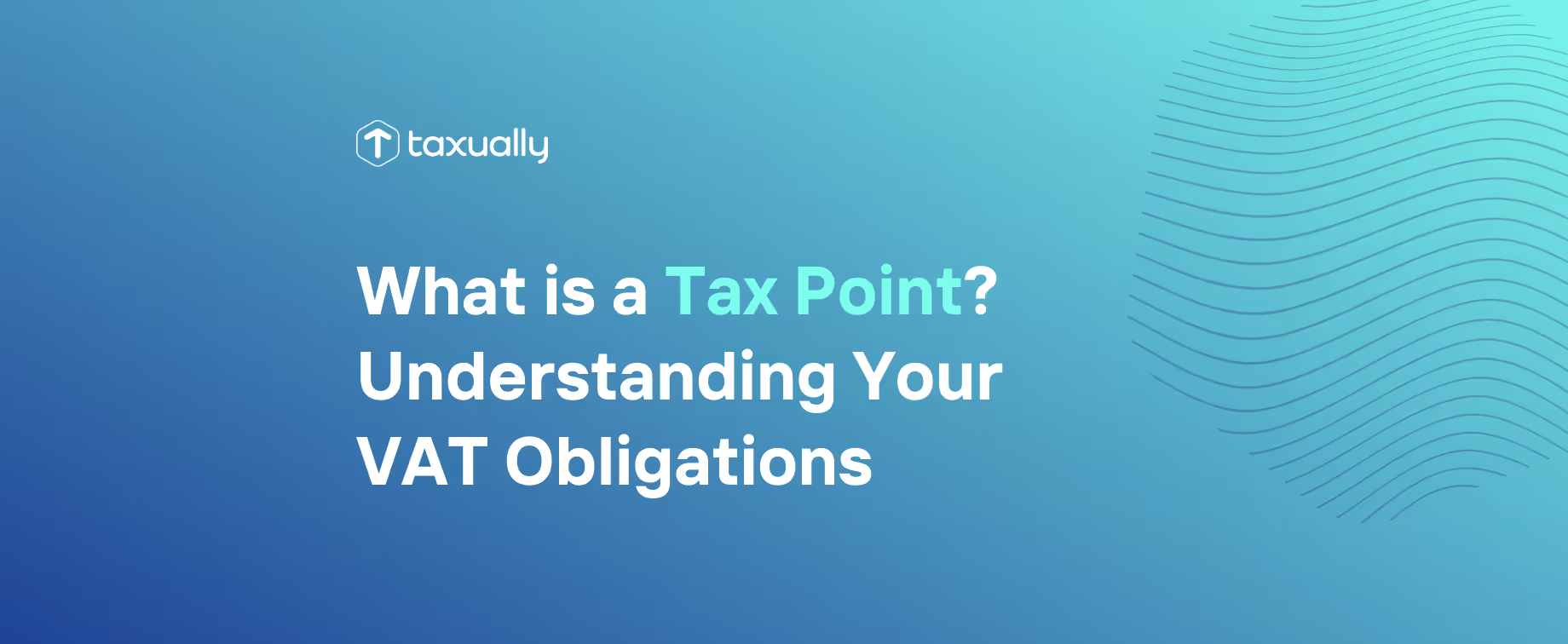Key takeaways
- Tax points determine when VAT is due: The tax point—also called the time of supply—is the moment VAT becomes chargeable and must be reported in your VAT return.
- Basic vs. actual tax point: While the basic tax point is tied to when goods are delivered or services completed, the actual tax point can be earlier if payment or an invoice is issued in advance.
- Advance payments and invoicing matter: Receiving deposits or issuing invoices before delivery can trigger earlier VAT obligations—so timely tracking is essential for compliance.
Determining when VAT needs to be paid? It all comes down to the tax point. Simply put, the tax point is the specific time at which the sale of goods or services is considered for VAT purposes. This moment determines when the tax must be reported and paid to the tax authorities. Let's look more closely at this concept to understand its importance and implications for businesses.
Defining the tax point in VAT transactions
The tax point, as previously discussed, signifies the date of a transaction for VAT purposes. This date is crucial for figuring out when VAT becomes due. It sets the time at which VAT becomes chargeable and determines the VAT period in which the VAT should be accounted for. In other words, it’s the specific moment when VAT becomes due on goods or services – also referred to as ‘time of supply’.
Interestingly, a single sale can have more than one tax point, reflecting multiple moments at which VAT may become due. This usually happens when a transaction is paid in stages or when there are advance payments. In essence, the tax point influences when VAT must be paid or reclaimed and which VAT rate applies.
Determining your basic tax point
The basic tax point holds significant importance in identifying VAT obligations. For a supply of goods, the basic tax point is determined at the time the goods are either removed or made available for the customer’s use. This means that the moment goods are taken off the premises or handed over to the customer, the basic tax point is established.
When it comes to services, the basic tax point is established on the date the services are performed. This means that the day you complete a service for a client is the day the basic tax point is set.
Identifying your actual tax point
Although the basic tax point serves as a primary guide, the actual tax point has the power to supersede it. Notably, the actual tax point can be established either before or after the basic tax point. But how is this determined? It comes down to the earliest of the date of supply, the invoice date, or the date of payment. These factors are pivotal in identifying when the VAT is due.
For example, if a VAT invoice is raised or payment is made before the basic tax point, the tax point is set at that earlier time. Conversely, if no VAT invoice is needed, the actual tax point becomes the date of supply. This flexibility serves to reflect the reality of business transactions more accurately.
The impact of advance payments
Advance payments or deposits can significantly impact the determination of the tax point. Specifically, an earlier actual tax point arises if a VAT invoice is issued or payment received in advance of the basic tax point. In other words, when a customer pays a deposit, a tax point is created for the amount received at that time.
VAT due on advance payments must be accounted for in the VAT return for the period in which the tax point occurs, whether it is when the deposit is received or a VAT invoice is issued. This means that businesses need to keep a close eye on advance payments to ensure they’re accurately accounting for VAT.

The role of VAT invoices in establishing tax point
VAT invoices hold significant importance in setting up tax points. But what makes a VAT invoice valid? To validly establish a tax point, a VAT invoice must include specific information such as:
- The supplier’s name and address
- The customer’s name and address
- The date of the supply
- A unique invoice number
- A description of the goods or services
- The quantity supplied
Additionally, the VAT invoice must specify the total amount of VAT charged, the individual unit price of the goods or services without VAT, and any discounts applied. In cases where the supply spans more than one tax period and the VAT rate changes, the invoice should detail the VAT rate and the amount of tax for each specific period.
Invoice date vs. supply date
In the context of ascertaining the tax point, it might be unclear whether the invoice date or the supply date takes precedence. The answer varies based on the situation. If an invoice is issued within 14 days of the date of supply, the invoice date prevails as the tax point for VAT purposes. This rule is often referred to as the ‘14 Day Rule’.
However, if an invoice is not issued, or is issued later than 14 days after the supply date, the supply date itself becomes the tax point. This flexibility ensures that the tax point accurately reflects the reality of business transactions, whether invoices are issued promptly or delayed.
The cash accounting scheme and tax points
The Cash Accounting Scheme is another factor that can influence tax points. Under this scheme, the actual tax point occurs on the date the payment is received rather than the invoice date. This can be advantageous for businesses as it allows them to delay VAT payments until actual cash is received, potentially aiding cash flow.
Eligible small businesses, particularly those with a VAT taxable turnover of £1.35 million or less, should consider the Cash Accounting Scheme. This scheme also benefits businesses by allowing them to reclaim VAT on their purchases only when they have paid their suppliers.
Tax point examples
These examples demonstrate how the occurrence of tax points can vary depending on the specifics of each transaction. The presence of advance payments, the nature of the supply, and the issuance of invoices can all influence when and how many tax points are established.
Services rendered: when does the tax point occur?
A web designer completes a piece of work on December 1st and issues the invoice to their customer on January 1st. The tax point in this case is the day they completed the work, December 1st, not the date payment invoice was issued.
For service-based transactions, the tax point can be:
- the date of supply if no invoice is needed.
- the invoice date if issued within 14 days after the date of supply.
- the date of supply if the invoice is issued after 14 days.
This flexibility allows businesses to delay paying output tax until the customer pays the invoice, improving cash flow.
Goods delivered: understanding the time of supply
When it comes to goods, the determination of the tax point can be influenced by advance payments. For example, when an advance payment is received before the supply of goods and prior to issuing a VAT invoice, the tax point occurs on the date the payment is received. This means that businesses need to track any advance payments carefully to ensure they’re accurately accounting for VAT and input tax.
Understanding the time of supply is crucial in determining the tax point for goods. Whether it’s the date the goods are made available to the customer, the date the payment is received, or the date the invoice is issued, businesses need to be vigilant in tracking these dates to ensure VAT compliance.

Special cases and exceptions to the rule
While the principles mentioned earlier are generally applicable, certain special cases and exceptions can influence tax points. For instance, the actual tax point for continuous supplies of goods and services may deviate from the basic tax point due to the ongoing nature of these transactions.
Also, when VAT rates change during the period covered by an invoice for continuous supplies, businesses can apply the new VAT rate to the portion of the supply that occurs after the rate change, despite an earlier normal tax point. This adaptability ensures that the tax point accurately reflects the reality of business transactions, even in the face of VAT rate changes.
Dealing with delayed invoices
Delayed invoices can also affect the tax point. When services are provided but the invoice is delayed, the tax point is typically the date the service was completed if the invoice is issued more than 14 days after this date. This means that businesses need to be mindful of their invoicing practices to ensure they’re accurately accounting for VAT.
Handling returns and adjustments
Returns and adjustments can also alter the original tax point. When goods are returned, the original tax point may be adjusted, necessitating a corresponding amendment in the VAT return to account for the reversal of the sale.
Adjustments to the price of goods or services after the initial sale, like discounts or rebates, can shift the tax point, impacting when the revised amount of VAT is due. In such cases, a credit note should be issued to document the decrease in taxable amount, resulting in a reduction of output tax on the seller’s VAT account.
Tips for small businesses on managing tax points
Having explored the theoretical aspects and examples of tax points, let’s shift our focus to some practical advice for small businesses to manage their tax points effectively. A key strategy is leveraging dedicated VAT software. This can help businesses accurately track tax points and ensure compliance.
An efficient invoicing and payment tracking system is also essential. This not only establishes clear tax points but also keeps reliable financial records. Regularly reviewing tax point records allows for any discrepancies to be spotted quickly, preventing compounded errors over successive VAT periods.
Best practices for timely invoicing
Prompt invoicing is vital for effective tax point management. Outlining payment terms and invoicing processes at the start of client relationships ensures transparency and avoids later confusion. Automating the sending of invoices and reminders with invoicing software reduces workload and improves the client experience, leading to more efficient invoicing practices.
Strategies for aligning payments and tax points
Another significant strategy involves aligning payments with tax points. Under the Cash Accounting Scheme, VAT is only accounted for when payment is actually received, which can help businesses better align their cash flow with VAT liability. Automating payment processes can increase the chances of receiving payments at the time when the tax points are established, thus maintaining financial coherence.
Incentives for early payment can also encourage clients to settle their invoices sooner, aligning payment inflows with VAT obligations. This can help businesses forecast their VAT liabilities based on their tax points, plan ahead for payments, and avoid unexpected cash shortages.
Conclusion
The tax point is a fundamental concept in VAT law, determining when the tax on goods and services is due. By understanding and correctly applying the rules regarding tax points, businesses can ensure compliance, manage cash flow effectively, and maintain accurate records. As VAT laws can be complex and vary by jurisdiction, staying informed and seeking expert advice when necessary is key to navigating VAT obligations successfully.
Do you need help with your VAT compliance? Book a free call with one of our VAT experts to find bespoke solutions for your business, optimize your VAT costs, and reach millions of new potential customers.
Frequently asked questions
New Year's Day - 1/1/2024Memorial Day - 5/27/20244th of July - 7/4/2024Labor Day - 9/2/2024Thanksgiving Day - 11/28/2024Day after Thanksgiving - 11/29/2024Christmas Eve - 12/24/2024Christmas Day - 12/25/2024
What is a tax point in VAT?
A tax point—also known as the time of supply—is the moment when VAT becomes chargeable on a sale. It determines when VAT must be reported and paid to the tax authorities.
What’s the difference between a basic and actual tax point?
The basic tax point is when goods are delivered or services completed. The actual tax point can override this if a VAT invoice is issued or payment is received before or shortly after that event.
When does an advance payment create a tax point?
A tax point is triggered when an advance payment is received or a VAT invoice is issued before the goods are delivered or the service is completed.
How does the 14-day rule work?
If you issue a VAT invoice within 14 days of the supply date, the invoice date becomes the tax point. If issued after 14 days, the supply date is the tax point.
How does the Cash Accounting Scheme affect tax points?
Under this scheme, VAT is due only when payment is received, not when an invoice is issued—helping small businesses better align cash flow with tax obligations.



















